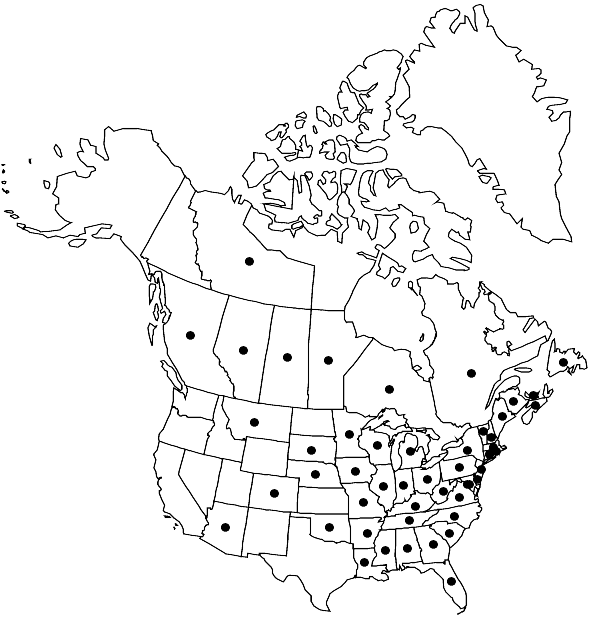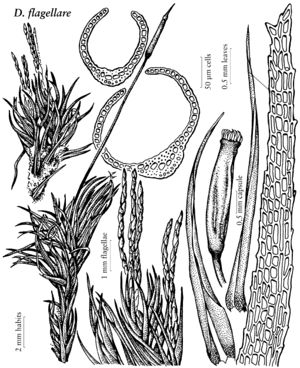Dicranum flagellare
Sp. Musc. Frond., 130. 1801,.
Plants in dense tufts, usually bearing 2–6 dark green, stout, terete branchlets, 1–4 mm, in the axils of the distal leaves, each flagelliform branchlet with short, ovate to lingulate, broadly acute to obtuse, ecostate or shortly and indistinctly costate leaves closely appressed to the axis, yellowish green to dark green, glossy. Stems 0.5–6 cm, densely tomentose with light brown to reddish brown rhizoids. Leaves falcate-secund to nearly straight, crisped to weakly crisped when dry, smooth, (1–)2–4(–5) × 0.3–0.6 mm, concave below, tubulose above, from a lanceolate or ovate-lanceolate base to an acuminate subula, apex acute; margins smooth to serrulate above; laminae 1-stratose; costa percurrent or sometimes ending just before apex, 1/6–1/4 the width of the leaves at base, smooth to ± rough with papillae or small teeth on abaxial surface near apex of leaf, abaxial ridges absent, with a row of guide cells, two stereid bands above and below not extending above the leaf middle, adaxial epidermal layer of cells not differentiated, the abaxial layer with some cells differentiated; cell walls between lamina cells not bulging; leaf cells smooth or weakly abaxially prorate above; alar cells 1-stratose, distinctly differentiated, not extending to costa; proximal laminal cells elongate-rectangular, not pitted or with few pits, (12–)24–38(–70) × (4–)10–15(–18) µm; distal laminal cells short-rectangular to quadrate, not pitted, (5–)12–14(–23) × (5–)7–12(–14) µm. Sexual condition dioicous; male plants as large as females; interior perichaetial leaves abruptly long-acuminate, convolute-sheathing. Seta 1–2.5 cm, solitary, yellowish to brown. Capsule 1.5–3 mm, straight and erect or nearly so, striate when dry, yellowish brown to brown; operculum 0.5–l.6 mm. Spores 12–19 µm.
Phenology: Capsules mature in spring.
Habitat: Rotting wood, especially stumps and logs, base of trees, exposed tree roots, soil or humus over boulders usually in mesic woods, sometimes swamps and bogs
Elevation: 0-1300 m
Distribution

Alta., B.C., Man., N.B., Nfld. and Labr. (Nfld.), N.W.T., N.S., Ont., P.E.I., Que., Sask., Ala., Ariz., Ark., Colo., Conn., Del., D.C., Fla., Ga., Ill., Ind., Iowa, Ky., La., Maine, Md., Mass., Mich., Minn., Miss., Mo., Mont., Nebr., N.H., N.J., N.Y., N.C., Ohio, Okla., Pa., R.I., S.C., S.Dak., Tenn., Vt., Va., W.Va., Wis., Mexico (Chihuahua, Coahuila, Durango, Jalisco, Nuevo León, Tamaulipas), West Indies, Central America (Costa Rica, Guatemala, Panama), Europe, Asia.
Discussion
Dicranum flagellare has been reported from Northwest Territories by W. L. Peterson (1979) and Arizona by I. M. Haring (1961). It is easily recognized because of the presence of unique axillary, flagelliform branchlets, in clusters of 2–6, which some plants in each colony almost always possess. The branchlets are deciduous and represent another type of asexual reproduction present in species of Dicranum, e.g. deciduous branchlets with linear, crisped leaves in D. montanum, and deciduous leaf tips in D. fragilifolium, D. tauricum and D. viride. C. E. Correns (1899) discussed the flagelliform branchlet type of asexual reproductive in D. flagellare as well as the other types of asexual reproduction occurring in the genus. The only species likely to be confused with D. flagellare if the flagelliform branchlets are overlooked or cannot be found is 25. D. montanum. For distinctions see the discussion under that species.
Selected References
None.
